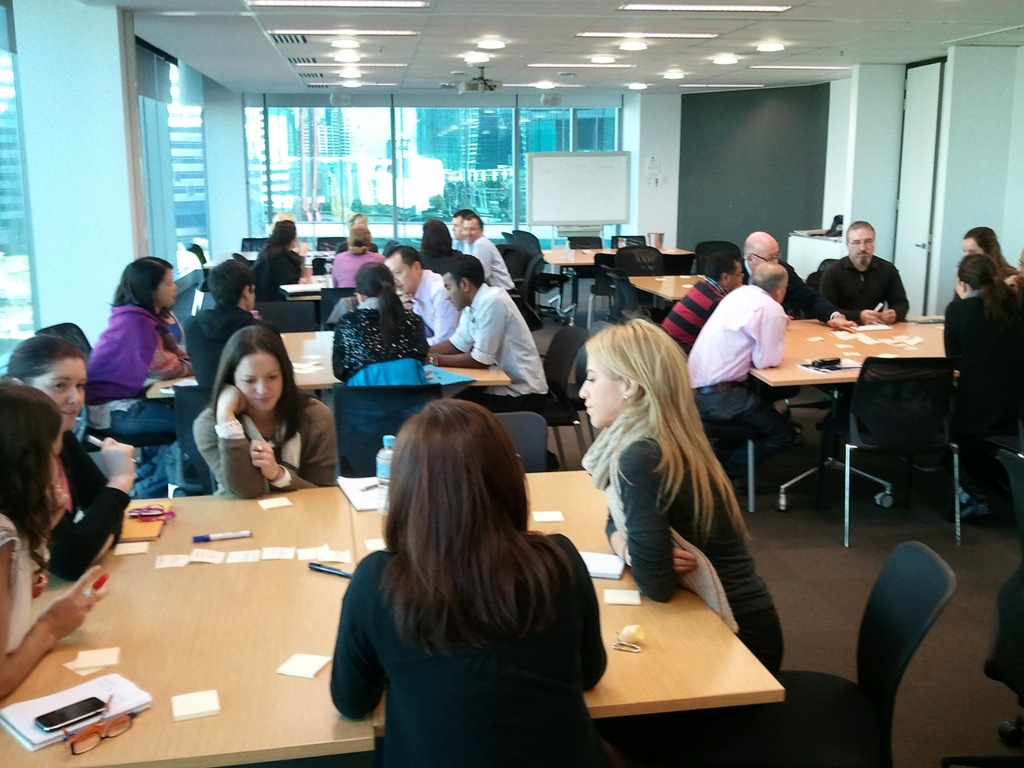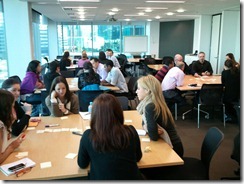"How do we prioritize all this work?" "What are mechanisms you use to prioritize?" "What if I have a lot of options that are all equal?" These are all valid questions and prioritization is an important function of both home and professional work. However, we find most often that prioritization issues, like trust issues, are a symptom of deeper problems. This video discusses what some of those root causes are and how we at Modus Cooperandi approach them.
Lean Coffee–Value Through Flexibility and Democracy
Where it came from
In 2009, Jeremy Lightsmith and I were sitting at a coffee shop wondering about how to start a new Lean-thinking community of practice in Seattle. This sounded like a great idea, but neither of us had enough time to devote to running yet another professional organization.
So I suggested that we make it self organizing. We find a place, a time, and an open-but directed, format.
Value Through Flexibility
Each Lean Coffee Meeting works like this:
- Framework: Draw a Personal Kanban
- Personal Agendas: Invite attendees to write their topics on sticky notes
- Democratization: Giving them two votes each, ask attendees to vote on the topics on the table
- Group Agenda: Prioritize the sticky notes
- Discuss
There are three main things happening here:
- There is a tight enough framework for focus
- There is a loose enough framework for new ideas to appear, and
- The framework gives everyone ownership.
Why is this important?
In a Lean Coffee style meeting, no one “owns” the agenda – it is created on-the-fly. A meeting is called with a topic and maybe a few item to be discussed. This format allows the good brains you invited to your meeting (I hope you invited good people) to extend the agenda in useful ways. Since the group votes for items discussed, chances that people will drone or or otherwise hijack the meeting are much less.
Where We’ve Used It
Since launching the Seattle Lean Coffee group in Seattle, we’ve brought Lean Coffee style meetings to organizations including, RW Baird, The Library Corporation, Comcast, Nordstrom, and The United Nations (in offices worldwide). In the corporate setting, we’ve found the lean coffee format to greatly lessen the amount of time wasted trying to “get on the same page,” and greatly increase the productivity and effectiveness of the gathered group.
What This Means
Getting On The Same Page – Most meetings waste a lot of time discussing background to issues that everyone already knows. The Lean Coffee format asks people to write what they wish to talk about on sticky notes and place them into a to-discuss area. When everyone sees the gathered topics, they get context of the topics individually and in relationship to other topics. Seeing this, attendees can quickly align around the topics, their meanings, and the goals of the meeting.
And if they can’t? Well, then we’ve just discovered something valuable to discuss.
Increased Productivity and Effectiveness – Meetings tend to waste a lot of time talking about talking. We will go over the agenda, we will discuss how the agenda isn’t perfect, we will rigidly stick to the agenda. People are frustrated with meetings not because they don’t want to work together, but because they view them as ineffective and, therefore, as interruptions in their day. With a Lean Coffee, groups can create a relevant agenda designed to quickly achieve value.
Speaking from Power in an Uncertain World–Collaberwocky Episode 3
Are you a manager trying to get by in a flat or agile company? Do you find the role of manager repeatedly maligned?
This is more than just “It’s lonely in the middle.” There are significant positive shifts in making the workplace more productive, efficient and effective. However, each of these shifts has been accompanied by changes in roles – and these changes are rarely clearly spelled out.
In Episode 3 of Collaberwocky, Jabe Bloom, Corey Ladas, and I discuss how to speak from power in this new uncertain world.
The Language of Management–Collaberwocky Episode 2
In this episode of Collaberwocky, Jabe Bloom, Corey Ladas and I discuss “The Language of Management.” It seems that different rungs of the corporate ladder come with different perspectives. None are complete and all have their own biases and areas of focus.
Further, many management theories give rise to a sort of class warfare between the different rungs. “My manager doesn’t understand me.” “The C-Level suite are out of touch.” “The people who work for me are idiots.”
Far too often, this causes the rungs to appear so far apart that people cannot even fathom having productive conversations. Corey, Jabe and I mull over these issues.



